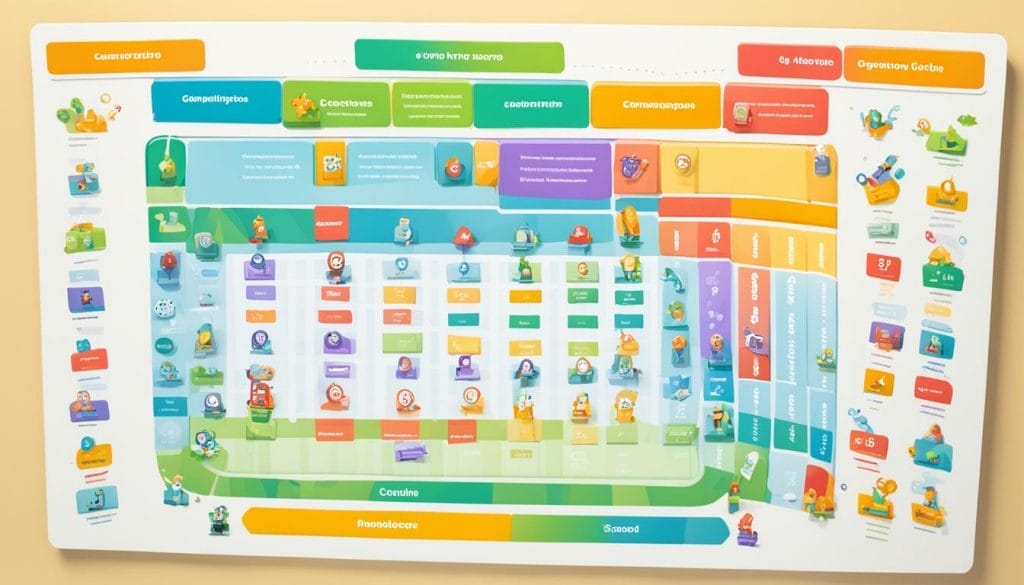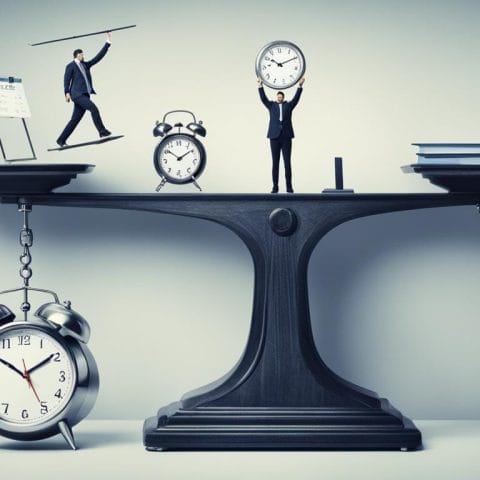Did you know 70% of the top 2000 companies use gamification? This shows how big gamification is in business, especially for onboarding new employees. Companies are finding new ways to keep new hires interested and happy, and gamified onboarding is a big part of that.
Gamification makes things more fun by adding game-like elements. It uses our love for competition and rewards to keep us interested. In onboarding, it makes the process fun and memorable.
Gamification has been around for a while, starting with rewards programs in stores and worker competitions. But it’s now more popular than ever. With interactive activities, companies are seeing better engagement and fewer employees leaving.
This article will look at 8 great examples of using gamification in onboarding. We’ll see how companies make onboarding fun, effective, and enjoyable. From points and badges to quests and virtual worlds, gamification is changing how companies welcome new employees.
Key Takeaways
- 70% of top global companies use gamification strategies
- Gamification applies game mechanics to boost engagement
- Employee onboarding gamification examples show improved retention
- Interactive onboarding activities tap into natural human motivations
- Gamified onboarding processes can transform the new hire experience
- Effective gamification strategies balance fun with learning objectives
Understanding Gamification in Employee Onboarding
Gamification is changing how we onboard employees, making it fun and effective. It adds game-like elements to everyday tasks, turning them into fun challenges.
Definition of gamification
Gamification in onboarding uses game mechanics to make learning fun and interactive. It includes things like points, challenges, and leaderboards. These elements tap into our desire for achievement and competition.
Benefits of gamified onboarding
Gamified onboarding has big benefits. 89% of employees feel more productive with it, and 88% are happier. It boosts engagement, cutting turnover by 43%. It also helps new hires remember more, with 90% finishing reading lists.
Key elements of successful gamification
For gamification to work well in onboarding, it needs:
- Clear progress tracking
- Well-defined rules
- Challenging tasks
- Meaningful rewards
- Recognition of achievements
These elements make learning exciting and motivate new hires. They help them fit into the company culture better.
| Gamification Element | Impact on Onboarding |
|---|---|
| Points-based systems | Increases engagement by 33% |
| Onboarding leaderboards | Boosts completion rates by 25% |
| Motivational challenges | Improves knowledge retention by 40% |
The Psychology Behind Gamified Onboarding
Gamification makes onboarding fun and engaging by tapping into our brain’s reward system. It uses onboarding badges and rewards to boost employee motivation and retention. This approach is based on key psychological principles that influence human behavior.
Positive reinforcement is one such principle. When employees earn badges or points, their brains release dopamine, a neurotransmitter that makes us feel good. This leads to a sense of achievement and more engagement. In fact, 67% of U.S. households play games, spending about eight hours a week on them.
The endowed progress effect is another psychological factor. It happens when people feel they’re near finishing a task or goal. For example, LinkedIn’s profile completion progress bar motivates users to finish their profiles. It’s a simple yet effective way to keep new hires interested during onboarding.
Collaborative onboarding games also tap into our social nature. They create a sense of teamwork and friendly competition among new hires. A software development team using a gamified tool found they were more motivated when earning points for tasks. The top team even got a virtual team lunch voucher as a reward.
“Gamification has been proven to increase user motivation and engagement, as evidenced by DevHub increasing successful service usage from 10% to 80% through gamification techniques.”
By understanding these psychological principles, companies can make onboarding more effective and engaging. This makes the process more fun for new hires and improves long-term retention and performance.
Employee Onboarding Gamification Examples
Gamification in onboarding is now a key way for companies to keep new hires interested and reduce turnover. Let’s look at some great examples of how top brands use personalized onboarding quests and storytelling to make a mark.
Duolingo’s Streak System
Duolingo uses a streak system to keep users coming back every day. This simple idea has made Duolingo a hit, even though 77% of new apps get deleted within a day.
LinkedIn’s Profile Completion Progress Bar
LinkedIn’s progress bars in their onboarding made a big difference. They saw a 55% jump in people finishing their profiles. This shows how visual feedback can push users to complete their profiles, making the platform more useful for networking and job searching.
Headspace’s Personalized Onboarding Journey
Headspace makes a unique experience for new users with personalized onboarding quests. They celebrate each step completed with positive feedback. This keeps users hooked and motivated to keep meditating.
Brewdog’s Badge Rewards
Brewdog’s loyalty program uses badges to make onboarding fun. Their approach brought big wins:
| Metric | Improvement |
|---|---|
| Average Order Value | 100% increase |
| Purchasing Frequency | 400% higher |
| Email Click-through Rate | 136% increase |
These examples show how using stories and gamification can change the game for onboarding. It leads to more engagement and people sticking around. By adding these elements, companies can make onboarding more memorable and effective.
Implementing Points and Leaderboards in Onboarding

Points-based onboarding systems and leaderboards make onboarding fun for new hires. They make progress feel like a game and create a friendly competition. This motivates employees to finish tasks and check out new features.
Salesflare’s story shows how well gamified onboarding works. They used gamified checklists and saw a big jump in completion rates. Users went from finishing 4 tasks to 7.6 tasks, thanks to points and achievements.
Microsoft Teams saw a huge jump in using a new feature after introducing a team leaderboard. This shows how leaderboards can make new features more popular and encourage people to try new tools.
Points-based systems reward certain actions, helping new hires learn the ropes. For instance, ProdPad cut the time it took to convert users by 4 weeks. This was thanks to a “magically extending trial” where users got extra trial days for trying out features.
| Company | Gamification Strategy | Result |
|---|---|---|
| Salesflare | Gamified checklists | Doubled onboarding completion rates |
| Microsoft Teams | Competitive team leaderboard | 250% increase in new feature usage |
| ProdPad | Rewards for trying features | 4-week reduction in time to conversion |
Using points and leaderboards in onboarding really helps with employee engagement and productivity. With 95% of employees liking gamified systems, it’s clear these tools work well. They make onboarding more effective.
Creating Engaging Onboarding Challenges and Quests
Getting new hires on board is key. With 86% of employees making up their minds to stay or leave in the first six months, companies must innovate. Using motivational challenges and quests can increase engagement by up to 48%.
Designing Effective Onboarding Challenges
Make challenges fit each employee’s role and skills. Give them tasks like making cold calls or doing safety interviews. This method is more effective than old ways, boosting productivity and interest.
Balancing Difficulty and Reward
Finding the right balance in gamification is crucial. Challenges should be tough but doable. Rewards like points, badges, or praise help. Nine out of ten employees say gamification makes them more productive.
Incorporating Storytelling Elements
Adding a story to onboarding makes it more fun and memorable. Create a story where new hires are the heroes. This can make users stick around longer and use the platform more.
| Platform | Cost | Key Features |
|---|---|---|
| GroveHR | Free, Paid plans from $3/month | Onboarding checklist, Company social feed, Peer recognition |
| Connecteam | Free, Paid plans from $12/month | Mobile learning, Recognition and rewards, Online quizzes |
| Kahoot | Starts at $29/month | Accessible e-learning app, Collaborative challenges, Reporting and analytics |
By using these methods, companies can make onboarding fun and set new employees up for success right away.
Leveraging Virtual Environments for Immersive Onboarding

Virtual environments are changing how we onboard employees. They make learning feel real, helping new people understand their jobs better. This is especially true in fields like energy, manufacturing, mining, and construction.
Interactive activities in these virtual spaces have many benefits. They make learning easier, boost productivity, and offer training that fits each person’s needs. This means everyone gets training that suits them best.
Games in these virtual spaces help build teams and share company culture. They make employees more motivated and successful. They also let people from all over the world join in.
“Virtual reality in onboarding enhances engagement and enables exploring the workplace before physically starting the job.”
The metaverse is a cost-effective way for companies to train people. It cuts down on travel and training costs. It also keeps teams connected and supports remote workers with virtual tools.
| Benefits of Virtual Onboarding | Impact |
|---|---|
| Increased engagement | Higher retention rates |
| Personalized learning | Improved job satisfaction |
| Cost-efficient | Reduced training expenses |
| Global accessibility | Enhanced diversity |
Virtual escape rooms are becoming a new way to onboard employees. They give a peek into the company culture, boost teamwork, and sharpen problem-solving skills. These activities are both fun and effective, making training consistent and affordable.
Measuring the Success of Gamified Onboarding
It’s key to track how well employee onboarding gamification works. Companies can look at different metrics to see what’s working. This helps them make smart choices based on data.
Key Performance Indicators
Businesses should keep an eye on certain KPIs to see success:
- Completion rates of onboarding tasks
- Time to productivity for new hires
- Engagement levels during onboarding
- Early turnover rates
For example, Formapost cut early turnover from 25% to 8% with gamification in their onboarding.
Analyzing Employee Feedback
What employees say is very important for making the onboarding better. A survey showed 88% of employees like gamification in work software. This makes them happier, which can lead to staying with the company longer and doing better.
Long-term Impact on Retention and Performance
Gamified onboarding has a big impact over time. Companies with engaged teams do way better than those without. This shows how important it is to help employees grow and develop right from the start.
| Metric | Before Gamification | After Gamification |
|---|---|---|
| Employee Motivation | 31% felt bored | 62% felt motivated |
| Pipeline Activity | Baseline | 257% increase |
| Desirability of Company | Standard | 78% increase |
By watching these metrics, companies can make their onboarding better. This leads to happier employees and better results for the company.
Overcoming Challenges in Implementing Gamified Onboarding
Gamified onboarding has many benefits but also faces challenges. The main issue is finding the right mix of fun and important info. Interactive onboarding activities should be fun yet still teach new hires what they need to know. This balance is key, as 45% of new hires leave within a year.
Ensuring everyone feels included is another big challenge. Onboarding quests must fit different learning styles and likes. Generali Austria shows how it can work well with 434 new hires across 35 regions. They used fun learning methods and games, making it enjoyable for everyone.
Keeping gamification exciting over time is vital. The market for gamification is set to grow from $18.63 billion in 2023 to $46.44 billion by 2027. This means updates are needed to keep things fresh. Companies should make sure their gamified onboarding fits their culture and values for lasting success. When done correctly, gamification can help keep information in mind by up to 40%. It also boosts employee engagement, cutting job leaving by 87%.
FAQ
Q: What is gamification?
A: Gamification uses game elements to make products more engaging. It adds points, badges, and leaderboards to boost participation and productivity.
Q: What are the benefits of gamified onboarding?
A: Gamified onboarding makes starting a new app fun, not boring. It makes things simpler and more enjoyable. This approach increases the chance that users will stick around.
Q: What psychological principles does gamification tap into?
A: Gamification uses psychology to motivate people. It relies on positive reinforcement and other psychological effects to keep users engaged.
Q: Can you provide examples of successful gamified onboarding?
A: Duolingo uses streaks to keep users coming back every day. LinkedIn’s progress bar helped users finish their profiles faster. Headspace rewards users for completing onboarding.
Brewdog’s loyalty program gives badges for signing up and buying things, leading to more spending and more visits.
Q: How can points and leaderboards be used in onboarding?
A: Points and leaderboards make onboarding fun and competitive. They motivate users to do tasks and use the platform more. Leaderboards show off achievements, and points reward certain actions during onboarding.
Q: What makes for effective onboarding challenges and quests?
A: Good onboarding challenges match the user’s goals and skills. They should be hard enough to be interesting but not too hard. Adding stories to the challenges makes them more fun and memorable.
Q: How can virtual environments enhance onboarding?
A: Virtual environments make onboarding more immersive. They let users try out real-world scenarios and play games that help build teams and share company culture.
Q: How can the success of gamified onboarding be measured?
A: Success can be seen in how many people finish onboarding, how quickly they start being productive, and how engaged they are. Feedback from employees and long-term effects on keeping people around and their performance are also important.
Q: What challenges may arise when implementing gamified onboarding?
A: Challenges include making it fun without overwhelming users with too much info. Making sure everyone feels included is key. Keeping gamification exciting means updating it regularly.





